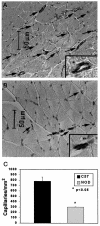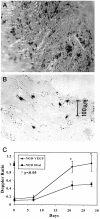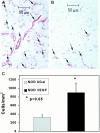Rescue of diabetes-related impairment of angiogenesis by intramuscular gene therapy with adeno-VEGF
- PMID: 10027394
- PMCID: PMC1850015
- DOI: 10.1016/S0002-9440(10)65282-0
Rescue of diabetes-related impairment of angiogenesis by intramuscular gene therapy with adeno-VEGF
Abstract
Diabetes is a major risk factor for coronary and peripheral artery diseases. Although diabetic patients often present with advanced forms of these diseases, it is not known whether the compensatory mechanisms to vascular ischemia are affected in this condition. Accordingly, we sought to determine whether diabetes could: 1) impair the development of new collateral vessel formation in response to tissue ischemia and 2) inhibit cytokine-induced therapeutic neovascularization. Hindlimb ischemia was created by femoral artery ligation in nonobese diabetic mice (NOD mice, n = 20) and in control C57 mice (n = 20). Hindlimb perfusion was evaluated by serial laser Doppler studies after the surgery. In NOD mice, measurement of the Doppler flow ratio between the ischemic and the normal limb indicated that restoration of perfusion in the ischemic hindlimb was significantly impaired. At day 14 after surgery, Doppler flow ratio in the NOD mice was 0.49+/-0.04 versus 0.73+/-0.06 for the C57 mice (P< or =0.005). This impairment in blood flow recovery persisted throughout the duration of the study with Doppler flow ratio values at day 35 of 0.50+/-0.05 versus 0.90+/-0.07 in the NOD and C57 mice, respectively (P< or =0.001). CD31 immunostaining confirmed the laser Doppler data by showing a significant reduction in capillary density in the NOD mice at 35 days after surgery (302+/-4 capillaries/mm2 versus 782+/-78 in C57 mice (P< or =0.005). The reduction in neovascularization in the NOD mice was the result of a lower level of vascular endothelial growth factor (VEGF) in the ischemic tissues, as assessed by Northern blot, Western blot and immunohistochemistry. The central role of VEGF was confirmed by showing that normal levels of neovascularization (compared with C57) could be achieved in NOD mice that had been supplemented for this growth factor via intramuscular injection of an adenoviral vector encoding for VEGF. We conclude that 1) diabetes impairs endogenous neovascularization of ischemic tissues; 2) the impairment in new blood vessel formation results from reduced expression of VEGF; and 3) cytokine supplementation achieved by intramuscular adeno-VEGF gene transfer restores neovascularization in a mouse model of diabetes.
Figures






References
-
- Aronson D, Rayfield EJ: Diabetes and obesity. Fuster V Ross R Topol EJ eds. Atherosclerosis and Coronary Artery Disease. 1996, :pp 327-362 Lippincott-Raven, Philadelphia
-
- Barzilai JI, Kronmall RA, Bittner V, Eaker E, Evans C, Foster ED: Coronary artery disease and coronary artery bypass grafting in diabetic patients age ≥ 65 years (Report from Coronary Artery Surgery Study (CASS) Registry). Am J Cardiol 1994, 74:334. - PubMed
-
- Kannel WB, McGee DL: Diabetes and cardiovascular disease: the Framingham Study. JAMA 1979, 241:2035-2038 - PubMed
-
- Currie CJ, Morgan CL, Peters JR: The epidemiology and cost of inpatient care of peripheral vascular disease, infection, neuropathy, and ulceration in diabetes. Diabetes Care 1998, 21:42-48 - PubMed
-
- Aronson D, Rayfield EJ: Diabetes. Topol EJ eds. Textbook of Cardiovascular Medicine. 1998, :pp 171-194 Lippincott-Raven, Philadelphia
Publication types
MeSH terms
Substances
Grants and funding
LinkOut - more resources
Full Text Sources
Other Literature Sources
Medical
Molecular Biology Databases

